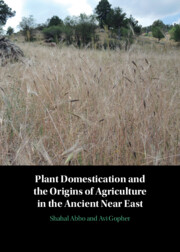Book contents
- Plant Domestication and the Origins of Agriculture in the Ancient Near East
- Plant Domestication and the Origins of Agriculture in the Ancient Near East
- Copyright page
- Contents
- Tables
- Foreword
- Foreword
- Preface and Acknowledgements
- Introduction
- 1 What Is the Agricultural Revolution?
- 2 From Hunter-Gatherers to Farmers in the Near East
- 3 Models That Describe and Explain the Agricultural Revolution, Including Plant Domestication
- 4 The Plant Formations of the Fertile Crescent and the Wild Progenitors of the Domesticated Founder Crops
- 5 The Difference between Wild and Domesticated Plants
- 6 Traditional versus Modern Agriculture – Stability vs Maximization
- 7 The Differences between Plant Domestication and Crop Evolution under Traditional and Modern Farming Systems
- 8 The Differences between Cereal and Legume Crops in the Near East
- 9 The Choice of Plant Species for Domestication
- 10 Where, When and How Did Near Eastern Plant Domestication Occur?
- 11 Domestication of Fruit Trees in the Near East
- 12 Plant Evolution under Domestication
- 13 A Global View of Plant Domestication in Other World Regions
- 14 Animal Domestication in the Near East
- 15 Plant Domestication and Early Near Eastern Agriculture
- Notes
- Further Reading
- References, Chapter 14
- Glossary: Basic Concepts in Genetics, Botany, Ecology, Agronomy and Zoology
- Index
6 - Traditional versus Modern Agriculture – Stability vs Maximization
Published online by Cambridge University Press: 12 March 2022
- Plant Domestication and the Origins of Agriculture in the Ancient Near East
- Plant Domestication and the Origins of Agriculture in the Ancient Near East
- Copyright page
- Contents
- Tables
- Foreword
- Foreword
- Preface and Acknowledgements
- Introduction
- 1 What Is the Agricultural Revolution?
- 2 From Hunter-Gatherers to Farmers in the Near East
- 3 Models That Describe and Explain the Agricultural Revolution, Including Plant Domestication
- 4 The Plant Formations of the Fertile Crescent and the Wild Progenitors of the Domesticated Founder Crops
- 5 The Difference between Wild and Domesticated Plants
- 6 Traditional versus Modern Agriculture – Stability vs Maximization
- 7 The Differences between Plant Domestication and Crop Evolution under Traditional and Modern Farming Systems
- 8 The Differences between Cereal and Legume Crops in the Near East
- 9 The Choice of Plant Species for Domestication
- 10 Where, When and How Did Near Eastern Plant Domestication Occur?
- 11 Domestication of Fruit Trees in the Near East
- 12 Plant Evolution under Domestication
- 13 A Global View of Plant Domestication in Other World Regions
- 14 Animal Domestication in the Near East
- 15 Plant Domestication and Early Near Eastern Agriculture
- Notes
- Further Reading
- References, Chapter 14
- Glossary: Basic Concepts in Genetics, Botany, Ecology, Agronomy and Zoology
- Index
Summary
To better understand the term ‘domestication syndrome’ (the group of traits that differentiate wild plants from domesticated crop plants; see Box 16 The domestication syndrome, p. 116), a deeper investigation into the differences between natural habitats, where wild species grow, and cultivated fields is required. In the agricultural context, actions taken are typically aimed at ensuring crop yields. These (husbandry) activities involve efforts that alter soil conditions, for example ploughing that aerates the soil, removes weeds and prepares it for sowing. To protect their fields and produce, farmers often create defensive systems (such as fencing) to minimize damages incurred by grazing wild animals (and later pasturing domesticated animals). Additionally, farming activities and crop growth may take place in a seasonal cycle that is different from that of wild populations. For example, under the Mediterranean climate, wild cereals begin to germinate immediately after the first autumn rains (October in the southern Levant, slightly earlier in the northern Levant). However, due to the absence of machinery with which to plough clay-rich soils prior to wetting of the soil profile in early winter, farmers in this area, working the land in traditional ways, would not have been able to sow before the month of December. The farming package may thus even have included completely off-season operations, such as the sowing of chickpea in the spring (further discussed below). To reduce competition over water and other resources between crops and wild weeds, farmers often sowed crops quite densely. This density of genetically similar or identical plants facilitated the spread of epidemics of different harmful agents – a phenomenon that is atypical of wild populations due to the wide species diversity in any given habitat and the genetic heterogeneity that characterizes each species. Later agricultural developments of irrigation and fertilization deepened the distinction between cultivated and natural habitats.
- Type
- Chapter
- Information
- Publisher: Cambridge University PressPrint publication year: 2022
- 1
- Cited by

